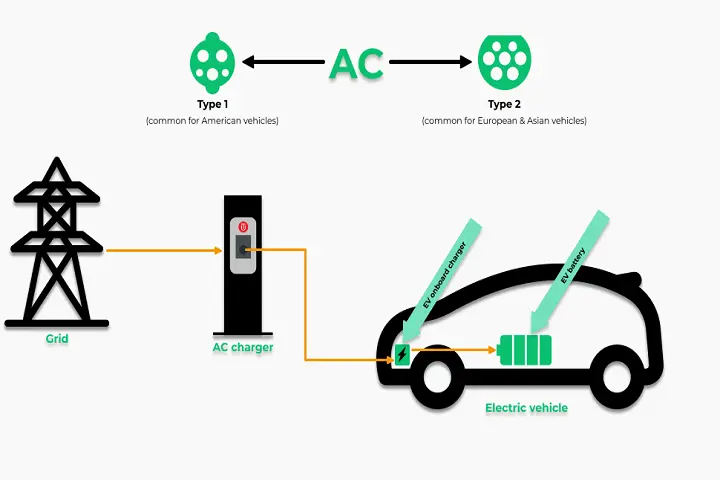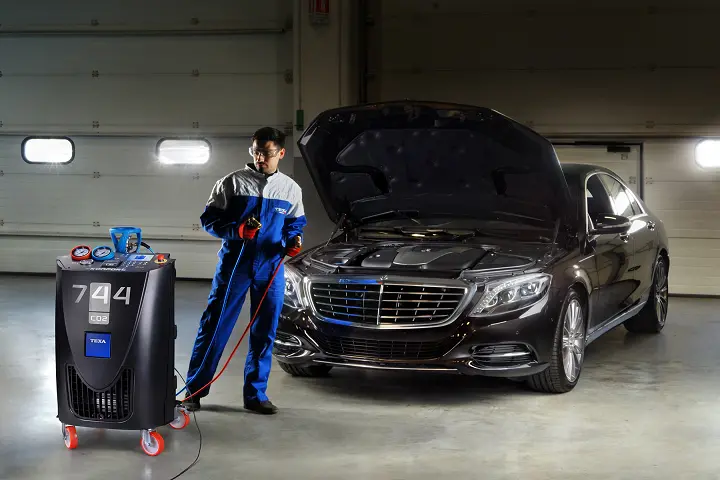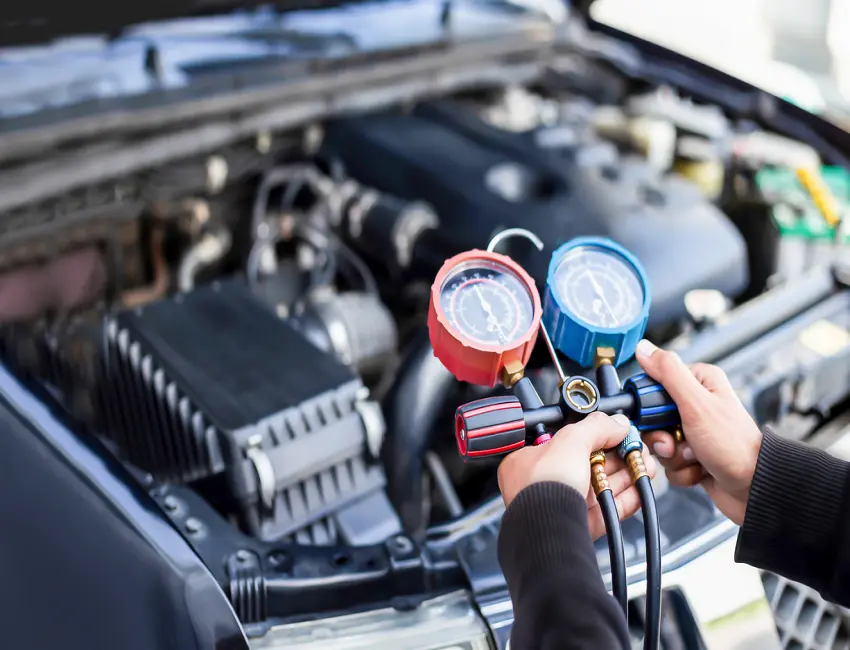Imagine cruising down a scorching highway, the sun beating down relentlessly on your car. Sweat starts to bead on your forehead and you reach for the A/C knob, desperate for relief.
But as you twist it to max, nothing happens. The vents wheeze out lukewarm air and your heart sinks. Your A/C has given up the ghost, leaving you to suffer in a four-wheeled sauna.
This scenario is all too familiar for many drivers and it often boils down to one crucial component: freon. But what exactly is freon for cars and why is it so important?
Buckle up as we take a deep dive into the world of automotive refrigerants, exploring everything from their history to the latest eco-friendly alternatives.
What is Freon?
Freon, a brand name that’s become synonymous with refrigerants, has been keeping cars cool for decades. But there’s more to this chilly chemical than meets the eye.
The Cool Chemistry Behind Freon
At its core, freon is a chlorofluorocarbon (CFC) or hydrochlorofluorocarbon (HCFC) compound. These chemicals have a unique property: they can easily transition between liquid and gaseous states, absorbing and releasing heat in the process. This makes them ideal for use in refrigeration and air conditioning systems.
In cars, freon circulates through the A/C system, undergoing phase changes that allow it to absorb heat from inside the vehicle and release it outside. It’s a bit like a molecular sponge, soaking up the warmth and wringing it out where it’s not wanted.
The process works like this:
- Low-pressure liquid freon enters the evaporator inside your car.
- It absorbs heat from the warm air in the cabin, changing to a gas.
- The now-gaseous freon travels to the compressor, which pressurizes it.
- This hot, high-pressure gas moves to the condenser at the front of your car.
- As it cools in the condenser, it releases heat to the outside air and returns to a liquid state.
- The cycle then repeats, continuously cooling your car’s interior.
A Brief History of Freon in Cars
Freon’s journey in automotive cooling began in the 1930s with the introduction of R-12, also known as Freon-12. This refrigerant revolutionized car comfort, making long summer drives bearable and even enjoyable. For decades, R-12 reigned supreme in vehicle A/C systems.
However, the 1980s brought a chilling revelation: CFCs like R-12 were damaging the Earth’s ozone layer. This discovery led to the phase-out of R-12 and the search for more environmentally friendly alternatives.
“The switch from R-12 to newer refrigerants marks one of the most significant shifts in automotive climate control technology.” – Dr. Sarah Cooley, Environmental Scientist
The timeline of this transition looks like this:
- 1930s: Introduction of R-12 for automotive use
- 1970s: Scientists begin to suspect CFCs of ozone depletion
- 1987: Montreal Protocol agrees to phase out ozone-depleting substances
- 1990s: Automotive industry begins transitioning to R-134a
- 2020s: Continued shift towards even more eco-friendly options like R-1234yf
Types of Refrigerants Used in Modern Cars
As environmental concerns grew, the automotive industry had to pivot quickly to find suitable replacements for R-12. This search led to the development and adoption of new refrigerants that could keep cars cool without harming the planet.
R-134a: The Common Replacement
In the 1990s, R-134a emerged as the go-to replacement for R-12. This hydrofluorocarbon (HFC) offered similar cooling performance without the ozone-depleting properties of its predecessor. R-134a quickly became the industry standard, finding its way into millions of vehicles worldwide.
Key Features of R-134a:
- Zero ozone depletion potential
- Efficient cooling capabilities
- Compatible with most modern A/C systems
- Widely available and relatively inexpensive
R-134a works in much the same way as R-12, but with some key differences:
- It requires different lubricants in the A/C system.
- It operates at higher pressures, necessitating some system modifications.
- While not ozone-depleting, it still has a significant global warming potential.
R-1234yf: The New Kid on the Block
As climate change concerns grew, even R-134a came under scrutiny due to its high global warming potential. Enter R-1234yf, a hydrofluoroolefin (HFO) refrigerant designed to have minimal environmental impact.
Advantages of R-1234yf:
- Extremely low global warming potential
- Breaks down quickly in the atmosphere
- Meets stringent environmental regulations
- Adopted by many major automakers
R-1234yf has some unique properties:
- It’s slightly flammable, though safety tests have shown the risk to be minimal in automotive applications.
- It’s more expensive than R-134a, partly due to more complex production processes.
- It requires specific handling procedures and equipment for servicing.
Comparing Efficiency and Environmental Impact

Let’s break down how these refrigerants stack up against each other:
| Refrigerant | Ozone Depletion Potential | Global Warming Potential | Cooling Efficiency | Typical Use Period |
| R-12 | High (1.0) | Very High (10,900) | Excellent | Pre-1994 |
| R-134a | Zero | Moderate (1,430) | Good | 1994-2021 |
| R-1234yf | Zero | Very Low (4) | Good | 2021-present |
As we can see, the evolution of freon for cars has been driven by a balance between cooling performance and environmental responsibility.
Signs Your Car Needs a Refrigerant Recharge
Now that we understand what freon is and how it’s evolved, let’s talk about how to spot when your car’s A/C system is running low. After all, catching these signs early can save you from that nightmare scenario we started with.
Weak Airflow from Vents
One of the first signs that your car might be low on freon is a noticeable decrease in airflow from the A/C vents. If you find yourself cranking up the fan speed just to feel a gentle breeze, it’s time to get your system checked.
This weak airflow can be caused by:
- Low refrigerant levels reducing the system’s overall efficiency
- Ice buildup on the evaporator due to improper pressure in the system
- A malfunctioning blower motor, which may be related to low refrigerant levels
A/C Not Cooling as Effectively
Perhaps the most obvious sign is when your A/C just isn’t cutting it anymore. If you’re setting the temperature lower and lower but still feeling the heat, your refrigerant levels might be to blame.
Here’s a quick test you can do:
- Start your car and turn the A/C to max cool.
- Let it run for a few minutes to stabilize.
- Use a thermometer to measure the temperature coming from the center vent.
- If it’s not reaching at least 10°C (50°F) below the outside temperature, you might be low on freon.
Strange Noises When A/C is Running
Listen closely. If you hear hissing or bubbling sounds when your A/C is on, it could indicate a refrigerant leak. These noises occur as the freon escapes through tiny holes in the system.
Other sounds to watch out for:
- Clicking: This could be the compressor trying to engage but failing due to low refrigerant.
- Rattling: While not directly related to freon levels, this could indicate a failing compressor, which might be caused by prolonged operation with low refrigerant.
Visible Refrigerant Leaks
While freon itself is invisible, the oil that circulates with it isn’t. If you spot oily residue around A/C components or fittings, it’s a clear sign that your system is leaking refrigerant.
Common places to check for leaks:
- Around hose connections
- Near the compressor
- At the condenser (usually in front of the radiator)
- Around the evaporator (typically inside the dashboard)
Pro Tip: Regular A/C system checks can catch these issues before they become major problems. Consider having your system inspected annually, preferably before the start of summer.
DIY vs. Professional Recharge: What You Need to Know
When faced with a failing A/C system, many car owners are tempted to take matters into their own hands. After all, auto parts stores sell DIY recharge kits, so how hard can it be? Let’s weigh the pros and cons.
Risks of DIY Recharging
While DIY kits might seem like a quick fix, they come with significant risks:
- Overcharging: Too much freon can damage your A/C compressor. It can cause liquid refrigerant to enter the compressor, leading to a catastrophic failure.
- Undercharging: Not enough refrigerant will result in poor cooling performance and can cause the compressor to overheat.
- Mixing Refrigerants: Using the wrong type can cause system failure and potentially dangerous chemical reactions.
- Safety Hazards: Refrigerants can be dangerous if not handled properly. They can cause frostbite on contact with skin or blindness if they get in your eyes.
- Environmental Concerns: Improper handling can release harmful chemicals into the atmosphere, contributing to ozone depletion or global warming.
Moreover, DIY recharging often doesn’t address the root cause of the problem. If your system is low on refrigerant, it’s because there’s a leak somewhere. Simply adding more freon is a temporary fix at best.
Tools and Knowledge Required
If you’re still considering the DIY route, here’s what you’ll need:
- Refrigerant gauge: To measure the pressure in your A/C system
- Protective gloves and eyewear: Essential for safety
- Proper refrigerant: Matching your car’s specifications (R-134a or R-1234yf)
- Understanding of your car’s A/C system: Including the correct refrigerant capacity
- Knowledge of local and federal regulations regarding refrigerant handling
You’ll also need to know how to:
- Locate the low-pressure service port on your A/C system
- Interpret pressure readings at different ambient temperatures
- Recognize signs of system malfunction beyond low refrigerant
When to Call in the Pros
Given the complexities and risks involved, professional service is often the wisest choice. Consider calling a certified technician if:
- You’re unsure about the type of refrigerant your car uses
- There’s a suspected leak in the system
- Your car is still under warranty (DIY work could void it)
- You lack the tools or confidence to perform the recharge safely
- The A/C hasn’t been serviced in several years
Remember, a professional not only recharges the system but can also diagnose underlying issues that a simple recharge won’t fix.
The Recharge Process Explained

Whether you opt for professional service or decide to brave the DIY route, understanding the recharge process can help you make informed decisions about your car’s A/C maintenance.
Evacuating the Old Refrigerant
The first step in any proper recharge is to remove any remaining refrigerant from the system. This is crucial because:
- It allows for accurate measurement of the new refrigerant added.
- It prevents mixing of different refrigerant types.
- It’s an opportunity to capture and recycle the old refrigerant, reducing environmental impact.
Professional technicians use specialized equipment to safely evacuate the system, ensuring no harmful gases are released into the atmosphere.
The evacuation process typically involves:
- Connecting a recovery machine to the A/C system
- Running the machine to pull out all refrigerant and oil
- Measuring the amount recovered to compare with the system’s capacity
- Disposing of or recycling the old refrigerant according to regulations
Leak Detection and Repair
Once the system is empty, it’s time to hunt for leaks. Technicians employ various methods:
- UV Dye: A fluorescent dye is added to the system and illuminated with a UV light to reveal leaks.
- Electronic Leak Detectors: These sensitive devices can sniff out even tiny amounts of escaping refrigerant.
- Nitrogen Pressure Test: The system is pressurized with nitrogen to reveal leaks that might not show up with other methods.
Any leaks found must be repaired before adding new refrigerant. Skipping this step is like trying to fill a leaky bucket – you’ll just end up wasting freon and money.
Common leak points include:
- Hose connections and fittings
- The compressor shaft seal
- Corroded condenser or evaporator coils
- Faulty pressure switches or sensors
Repairs might involve:
- Replacing O-rings or gaskets
- Tightening loose fittings
- Replacing damaged components
- Sealing small leaks in coils (though replacement is often necessary for larger leaks)
Adding the New Refrigerant
With leaks fixed, it’s time to recharge the system. This isn’t just a matter of pumping in freon until the gauge looks good. Proper recharging involves:
- Knowing the exact amount of refrigerant your specific car model requires.
- Adding the refrigerant slowly while monitoring system pressure.
- Checking for proper oil circulation in the system.
Overcharging or undercharging can lead to poor performance and potential system damage, which is why precision is key.
The recharge process typically looks like this:
- Vacuum the system to remove any air and moisture
- Add the specified amount of refrigerant oil (if necessary)
- Slowly add refrigerant while running the A/C system
- Monitor pressures on both the high and low sides of the system
- Check temperatures at the vents to ensure proper cooling
Testing the System
The final step is a thorough test of the newly recharged system. This includes:
- Checking vent temperatures at various fan speeds
- Monitoring system pressures during operation
- Ensuring proper cycling of the compressor
- Verifying that all components are functioning correctly
A properly recharged system should blow cold air consistently and operate quietly without any unusual cycling or noises.
Technicians will often use specialized equipment to perform a “performance test,” which measures:
- Airflow through the vents
- Temperature drop across the evaporator
- Compressor efficiency
- Overall system capacity
This comprehensive testing ensures that your A/C isn’t just charged, but performing at its best.
Maintenance Tips to Extend A/C Life
Now that your A/C is running smoothly again, let’s talk about how to keep it that way. Proper maintenance can significantly extend the life of your car’s cooling system, saving you money and headaches down the road.
Regular System Checks
Make A/C inspections a part of your routine car maintenance. Here’s a simple checklist:
- Check for unusual noises when the A/C is running
- Monitor cooling performance regularly
- Inspect visible components for signs of wear or damage
- Have a professional check refrigerant levels annually
You can also perform some basic checks yourself:
- Visual inspection: Look for any signs of oil leaks or damage to A/C components.
- Belt check: Ensure the compressor belt (if your car has one) is in good condition and properly tensioned.
- Cabin air filter: Replace this regularly to ensure good airflow and prevent strain on the system.
Keeping the Condenser Clean
The condenser, typically located at the front of your car, plays a crucial role in A/C performance. Keep it clean by:
- Regularly washing your car to remove debris
- Using compressed air to blow out insects and leaves
- Ensuring adequate airflow by keeping the grill clear
A clean condenser works more efficiently, reducing strain on the entire system.
Here’s why condenser cleanliness matters:
- Debris can block airflow, reducing cooling efficiency
- Dirt can act as insulation, preventing proper heat dissipation
- A clean condenser helps maintain proper system pressures
Running the A/C in Winter (Yes, Really!)
It might seem counterintuitive, but running your A/C occasionally during winter months can help maintain system health. Here’s why:
- It keeps seals and components lubricated
- It prevents mold and mildew growth in the system
- It allows you to catch potential issues before the heat of summer
Aim to run your A/C for about 10 minutes once a week, even in cold weather.
Additional winter A/C tips:
- Use the “defrost” setting, which typically engages the A/C to remove moisture from the air
- Listen for any unusual noises that might indicate developing problems
- If you notice any decrease in performance, have it checked before summer arrives
Environmental Considerations and Future Trends
As we’ve seen, the story of freon for cars is deeply intertwined with environmental concerns. Let’s explore the current state of affairs and peek into the future of automotive cooling.
Recycling Old Refrigerants
Proper disposal of old refrigerants is crucial to minimizing environmental impact. The EPA has strict guidelines for recovering and recycling used freon:
- Only certified technicians can handle refrigerant recovery
- Recovered refrigerant must be purified for reuse or destroyed
- Venting refrigerant into the atmosphere is illegal and subject to hefty fines
Many auto shops now have equipment to capture and recycle old refrigerants, turning potential pollutants into reusable resources.
Development of More Eco-Friendly Alternatives
The search for the perfect refrigerant continues. Scientists and engineers are working on alternatives that offer excellent cooling performance with minimal environmental impact. Some promising avenues include:
- Natural Refrigerants: Substances like CO2 and propane are being explored for automotive use.
- Engineered Molecules: New compounds designed to break down quickly in the atmosphere.
- Improved System Efficiency: Reducing the amount of refrigerant needed through better A/C design.
Potential Shift to CO2-Based Systems
Carbon dioxide (R-744) is emerging as a potential game-changer in automotive cooling. While it requires higher operating pressures, CO2 systems offer several advantages:
Benefits of CO2 Refrigerant:
- Extremely low global warming potential
- Non-flammable and non-toxic
- Excellent cooling performance, especially in hot climates
- Abundant and inexpensive
Several European automakers are already experimenting with CO2 systems, and this technology could become more widespread in the coming years.
Legal Aspects and Regulations

The use and handling of freon for cars isn’t just a matter of mechanical know-how – it’s also heavily regulated. Understanding these rules is crucial for anyone working with automotive A/C systems.
EPA Guidelines on Handling Refrigerants
The Environmental Protection Agency (EPA) has established strict guidelines for refrigerant handling:
- Only EPA-certified technicians can purchase or work with refrigerants
- Proper equipment must be used for recovery and recycling
- Accurate records must be kept of all refrigerant purchases and usage
- Intentional venting of refrigerants is prohibited
These regulations aim to minimize the environmental impact of automotive refrigerants and ensure proper handling and disposal.
State-Specific Rules to Be Aware Of
While federal regulations provide a baseline, many states have additional rules regarding refrigerant handling and disposal. For example:
- California: Has stricter emission standards and is phasing out high-GWP refrigerants faster than federal timelines.
- Florida: Requires additional certification for HVAC contractors working on automotive systems.
- New York: Has specific requirements for refrigerant recovery equipment in auto repair shops.
Always check your local regulations before attempting any A/C work.
Penalties for Improper Disposal
The EPA takes refrigerant violations seriously. Penalties can include:
- Fines up to $37,500 per day for each violation
- Criminal charges for intentional venting or improper disposal
- Revocation of certification for technicians who violate regulations
These steep penalties underscore the importance of proper handling and disposal of freon and other refrigerants.
Conclusion
As we’ve explored the world of freon for cars, it’s clear that this seemingly simple component plays a crucial role in our driving comfort and has a significant impact on our environment. From the early days of R-12 to the latest eco-friendly alternatives, the evolution of automotive refrigerants reflects our growing understanding of environmental stewardship.
Let’s recap the key points:
- Freon is essential for car A/C systems, but its formulation has changed over time due to environmental concerns.
- Modern refrigerants like R-134a and R-1234yf offer a balance of cooling performance and reduced environmental impact.
- Regular maintenance and proper handling are crucial for both system performance and environmental protection.
- The future of automotive cooling is trending towards even more eco-friendly solutions, with CO2 systems showing particular promise.
- Strict regulations govern the use and disposal of refrigerants, emphasizing their environmental significance.
As car owners, we all have a role to play in ensuring our vehicles are not just comfortable, but also environmentally responsible. Regular A/C maintenance, prompt attention to leaks, and choosing shops that follow proper refrigerant handling procedures are all ways we can contribute to this goal.
So, the next time you reach for that A/C knob on a sweltering day, take a moment to appreciate the complex system and evolving technology that’s keeping you cool. And remember, a well-maintained A/C system isn’t just about comfort – it’s a small but significant step towards a cooler, greener future for all of us.
Call to Action: Don’t wait for your A/C to fail on the hottest day of the year. Schedule a professional A/C check-up today to ensure your system is running efficiently and environmentally responsibly. Your comfort, your car, and our planet will thank you.

With over 5 years of dedicated experience in the automotive industry, I am passionate about all things automotive. My journey began with a deep curiosity for automobiles, which led me to delve deeper into their mechanics, technology and trends. My expertise spans various aspects of the automotive world, from the latest electric vehicles to classic car restoration techniques. Through my articles, I aim to share my knowledge and insights, helping readers stay informed and inspired in the fast-paced world of the automobile.











